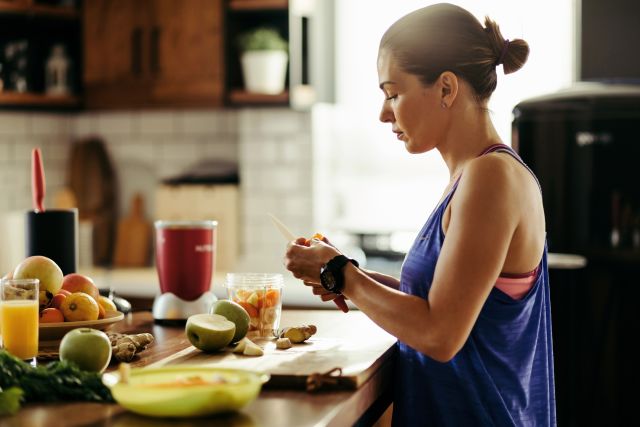Updated on October 14, 2022.
Eating just the right thing before lifting weights or jumping on the treadmill can help keep you energized through your workout. But what you should eat depends on how hard and how long you're exercising, says Elizabeth Somer, RD, author of Eat Your Way to Happiness.
Here are her strategies to fuel your muscles before different workouts and to help you recover once you’ve put in your work.
The workout: Moderate-intensity aerobic exercise for 30 to 60 minutes
Pre-workout: "A small liquid snack 5 minutes before a run, aerobics, or power yoga class turns into usable fuel almost immediately," says Somer. Let these rules be your guide:
- Keep it light (under 200 calories) for faster digestion.
- The less time you have available to eat before exercising, the less you should eat. You don't want food sloshing around in your stomach as you move.
- Skip juice blends or energy drinks that list high-fructose corn syrup or glucose gels on the label. Excessive sugar can make blood glucose levels rise and then crash during your workout.
Snacks under 200 calories to try:
- A blend-it-yourself 8-ounce smoothie made with whole fruit (fresh or frozen), low-fat yogurt, and a little water
- A 6-ounce glass of OJ and two graham crackers
Post-workout: To rehydrate and keep your blood glucose stable, have some water and one of these snacks:
- A low-fat granola or energy bar
- A cup of low-sodium chicken noodle soup
- A piece of fresh fruit
The workout: Moderate-intensity aerobic exercise for 60 minutes or more
Pre-workout: You want a snack that keeps muscles supplied with a steady flow of glucose. "Just as a car sputters to a stop when it runs out of gas, you 'hit the wall' or 'bonk' if your glucose supplies are drained,” warns Somer. “Once that happens, no snack will fuel you fast enough to finish the workout.” Before you go all out, have these:
- Water to ward off dehydration, especially in hot weather
- Carbs that are high-quality and easy to digest; they'll leave your GI tract quickly and supply enough glucose to fuel a long workout
- Protein from yogurt, milk, soymilk, or nuts to offset a rapid drop in blood glucose from eating those carbs
- Foods that are light (again, 200 calories) and low in fat, to avoid an upset stomach. If your energy dips or your legs become shaky, try eating a little more next time until you find the right amount for you.
Good carb/protein combos to try:
- Half of a 4-ounce whole-wheat bagel with 1 ounce turkey breast
- One small slice of last night's vegetarian pizza or two-thirds of a cup of leftover whole-grain spaghetti with marinara sauce
- One stick of low-fat string cheese, one medium pear, and three whole-grain crackers
Post-workout: Recover with more water and a 100-calorie, all-carb snack like these:
- 50 pretzel sticks
- Half a baked potato topped with 2 tablespoons of salsa
The workout: Up to 60 minutes of gentle yoga, stretching, or tai chi
Pre-workout: A pre-workout snack isn't essential for low-sweat activities like these. But if you're hungry, try a banana for potassium and two graham crackers for carbs. Wash it down with some water.
Post-workout: All you need is more water.
The workout: Moderate-intensity strength training for 30 to 45 minutes
Pre-workout: Carbs with protein—plus a dash of healthy fat—is your fuel of choice. Only weight lifters who pump iron for more than 45 minutes at least three days a week need extra protein, says Somer. "Most people get plenty.” If you do resistance exercise with some intensity, try these 200- to 250-calorie protein-laced snacks:
- Half a turkey sandwich on whole-grain bread and a piece of fruit
- One handful of trail mix (nuts, dried fruit, and seeds)
- Three whole-grain crackers with 1 tablespoon of peanut butter and 6 ounces of vegetable juice
For the average gym rat who does 30 minutes of weight training two or three times a week, just have a high-carb snack 10 minutes or so before you start. Some options include:
- Plain, nonfat yogurt mixed with berries or applesauce
- 1 tablespoon of nut butter (peanut, almond, or cashew) and one half of a sliced banana on a 10-inch whole-wheat tortilla, rolled up burrito-style
Post-workout: Rehydrate with water and have the other half of that turkey sandwich or a few more crackers with nut butter. The protein helps repair and build your muscles.
The workout: An all-day hike, cross-country ski, or snowshoe trek
Pre-workout: When you eat carbohydrates but don’t immediately burn them for energy, your body stores the excess sugar (aka glucose) as glycogen. Later, if you need extra glucose to power your body, your body will tap into those glycogen stores. To build up your glycogen stores for endurance exercise, plan ahead:
- For a day or two prior to your outing, eat high-carb meals of whole-wheat pasta or brown rice dishes. Add a little healthy fat in the form of a drizzle of olive oil or some parmesan cheese.
- Drink ample fluids, too—at least 10 cups a day. Before setting out, have a substantial high-carb meal of pancakes or waffles with fruit.
- In addition to lunch, pack a couple of energy bars or some dried fruit-and-nut mix to nibble every couple hours.
- Regularly sip water or sports drinks; don't wait until you get thirsty.
Post-workout: Soak in the hot tub! And keep drinking water. Have a high-carb snack—such as popcorn, pretzels, or a muffin with hot cocoa—before resuming your normal diet to help get a head start on rebuilding those glycogen stores.
Exercising regularly will not only burn off all those snacks and more, but could also make your RealAge as much as 9 years younger.







